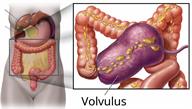Volvulus

Volvulus is an abnormal twisting of a portion of the digestive tract. The digestive tract begins with the part of the body that moves food from your mouth to your stomach (esophagus). It also includes the stomach, small intestine, and large intestine. With volvulus, the twisting can block the flow of food in the digestive system. This is called a bowel obstruction. It can also block the flow of blood to the part of the digestive tract that is twisted. Lack of blood flow can cause the twisted part of the digestive tract to die. Volvulus is a medical emergency.
There are various types of volvulus:
Sigmoid volvulus is a twisting of the last part of the large intestine. This is the most common type.
Midgut volvulus usually occurs in children who are born with an abnormally positioned small intestine (malrotation).
Cecal volvulus may be caused by scar tissue from previous abdominal surgery.
Gastric volvulus is a rare type of volvulus that occurs when the stomach twists around itself.
What are the causes?
This condition may be caused by many different things. Some common causes include:
What increases the risk?
You are more likely to develop this condition if:
You are 50 years of age or older.
You have long-term constipation, also known as chronic constipation.
A part of your stomach or other organs move up toward your chest (paraesophageal hernia).
You are bedridden.
You have had previous surgery in your abdomen.
You live in a long-term care facility.
What are the signs or symptoms?
Symptoms of most types of volvulus include:
- Pain in the abdomen.
Sigmoid volvulus may cause pain in the lower left part of the abdomen.
Cecal volvulus may cause pain in the lower right part of the abdomen.
Gastric and midgut volvulus may cause pain in the upper abdomen.
Tenderness when pressing on the abdomen.
Bloating and swelling of the abdomen.
Decreased passing of gas or inability to pass gas.
Nausea or vomiting.
Constipation.
As the condition gets worse, the volvulus can develop a hole (
perforation) and leak digestive contents into the abdomen. This can cause late signs of volvulus, including:
Severe infection (sepsis).
Bleeding into the abdomen.
Very low blood pressure (shock).
How is this diagnosed?
This condition may be diagnosed based on:
Your symptoms. The health care provider may suspect volvulus if you have sudden symptoms of intestinal obstruction.
A physical exam. During the exam, the health care provider will listen to your abdomen for the sounds of digestion and will feel your abdomen for tenderness.
- Imaging studies of your abdomen, such as:
How is this treated?
This condition is almost always a medical emergency that requires surgery right away. Treatment may include:
Emergency colonoscopy. A lubricated, flexible tube with a camera is inserted into the opening between the buttocks (anus) and then passed into the rectum, colon, and other parts of the large intestine. If your volvulus is in the large intestine, this procedure may unblock the twisted part.
An abdominal surgery to untwist the volvulus.
Removing a part of your digestive tract (resection), if your volvulus cannot be untwisted.
Follow these instructions at home:
-
Follow instructions from your health care provider about recovery after your procedure.
-
Take over-the-counter and prescription medicines only as told by your health care provider.
-
Get plenty of rest.
-
Follow instructions about eating restrictions. You may need to avoid solid foods and consume only clear liquids until your condition improves.
-
Keep all follow-up visits. This is important.
-
You have increased pain or cramping.
-
You have a fever.
-
Your abdomen is swollen.
-
You have nausea or vomiting.
-
You have blood in your stool or vomit.
Summary
-
Volvulus is an abnormal twisting of a portion of the digestive tract.
-
Lack of blood flow can cause the twisted part of the digestive tract to die.
-
Pain in the abdomen, nausea, vomiting, and an inability to pass gas are symptoms of volvulus.
-
Volvulus is a medical emergency. It usually requires surgery right away.
This information is not intended to replace advice given to you by your health care provider. Make sure you discuss any questions you have with your health care provider.
